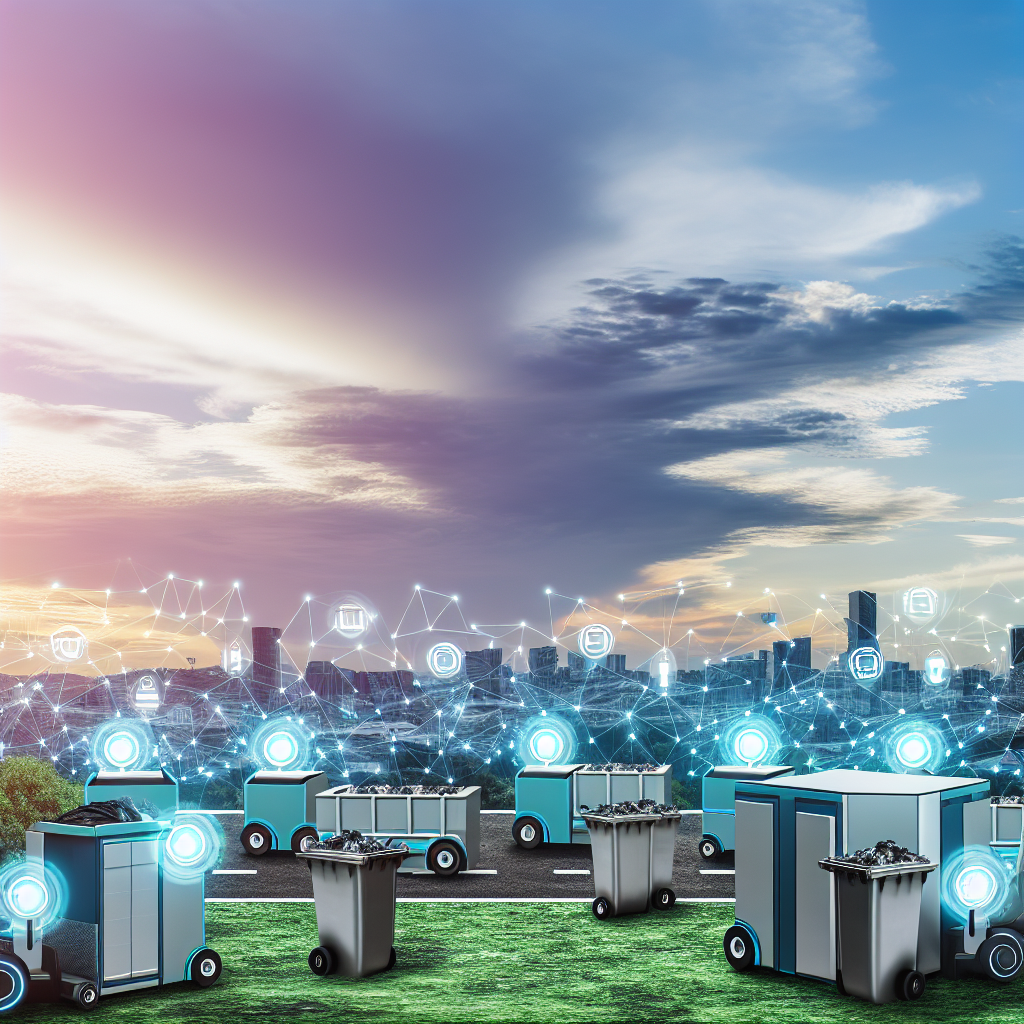Revolutionizing Waste Management: How IoT Waste Solutions Are Transforming Valet Trash Services in 2025
In recent years, the waste management industry has witnessed a significant transformation, driven by the integration of Internet of Things (IoT) technologies. As we look towards 2025, valet trash services are poised to benefit immensely from these advancements, offering more efficient, sustainable, and customer-centric solutions. The incorporation of IoT in waste management is not merely a trend but a necessity, as urban areas continue to expand and the demand for streamlined waste disposal services grows. By leveraging IoT technologies, valet trash services can optimize their operations, reduce costs, and enhance customer satisfaction.
One of the primary ways IoT is revolutionizing valet trash services is through the use of smart sensors. These sensors, when installed in waste bins, provide real-time data on fill levels, enabling service providers to optimize collection schedules. This data-driven approach ensures that waste is collected only when necessary, reducing unnecessary trips and minimizing fuel consumption. Consequently, this not only leads to cost savings but also contributes to a reduction in carbon emissions, aligning with global sustainability goals. Moreover, the ability to monitor waste levels remotely allows service providers to respond promptly to overflow situations, thereby maintaining cleanliness and hygiene in residential complexes.
In addition to smart sensors, IoT-enabled waste management systems are incorporating advanced analytics and machine learning algorithms. These technologies analyze data collected from various sources to predict waste generation patterns and optimize route planning. By understanding these patterns, valet trash services can allocate resources more effectively, ensuring that manpower and vehicles are utilized efficiently. This predictive capability is particularly beneficial in high-density urban areas, where waste generation can vary significantly based on factors such as time of day, weather conditions, and local events.
Furthermore, the integration of IoT in valet trash services enhances communication between service providers and residents. Mobile applications and online platforms allow residents to report issues, schedule pickups, and receive notifications about service updates. This level of transparency and communication fosters trust and satisfaction among residents, as they are kept informed and can actively participate in the waste management process. Additionally, these platforms can be used to educate residents about recycling practices and waste reduction strategies, promoting a more sustainable community.
As we approach 2025, the role of IoT in valet trash services is expected to expand further with the advent of smart city initiatives. These initiatives aim to create interconnected urban environments where data from various sectors, including waste management, is integrated to improve overall city operations. In this context, valet trash services can collaborate with municipal authorities to share data and insights, contributing to a more comprehensive and efficient waste management system. This collaboration can lead to the development of innovative solutions, such as dynamic pricing models based on waste generation or incentives for residents who actively participate in recycling programs.
In conclusion, the integration of IoT technologies in valet trash services is set to revolutionize the waste management industry by 2025. Through smart sensors, advanced analytics, and enhanced communication platforms, these services can achieve greater efficiency, sustainability, and customer satisfaction. As urban areas continue to grow, the adoption of IoT solutions will be crucial in addressing the challenges of waste management, ultimately leading to cleaner and more sustainable communities. The future of valet trash services lies in their ability to adapt and innovate, leveraging technology to meet the evolving needs of residents and the environment.
Smart Trash Systems: The Future of Automated Collection in Valet Trash Services
As urban living continues to evolve, the demand for efficient waste management solutions has become increasingly critical. Valet trash services, which have traditionally relied on manual collection methods, are now poised for a technological transformation. The integration of smart trash systems represents a significant leap forward, promising to revolutionize the way valet trash services operate by 2025. These innovations are not only set to enhance operational efficiency but also to address environmental concerns and improve customer satisfaction.
At the heart of this transformation is the implementation of automated collection systems. These systems utilize advanced sensors and Internet of Things (IoT) technology to monitor waste levels in real-time. By equipping trash receptacles with sensors, valet trash services can optimize collection schedules, ensuring that waste is collected only when bins are full. This approach not only reduces unnecessary trips, thereby lowering fuel consumption and emissions, but also ensures that waste is managed more effectively, preventing overflow and maintaining cleanliness in residential complexes.
Moreover, the data collected from these smart systems can be analyzed to gain insights into waste generation patterns. This information is invaluable for both service providers and property managers, as it allows for more accurate forecasting and resource allocation. For instance, understanding peak waste generation times can help in deploying additional resources during high-demand periods, thus enhancing service reliability. Additionally, this data-driven approach can inform sustainability initiatives, such as targeted recycling programs, by identifying areas with high recyclable waste output.
Transitioning to smart trash systems also opens up opportunities for enhanced customer engagement. Through mobile applications, residents can receive notifications about collection schedules, report issues, and even track their waste generation habits. This level of transparency and interaction fosters a sense of community involvement and encourages residents to participate actively in waste reduction efforts. Furthermore, by providing feedback mechanisms, these platforms enable service providers to address customer concerns promptly, thereby improving overall satisfaction.
In addition to operational benefits, the adoption of smart trash systems aligns with broader environmental goals. By optimizing collection routes and reducing the frequency of collections, these systems contribute to a reduction in carbon emissions. Furthermore, the ability to monitor waste composition can support recycling and composting initiatives, ultimately diverting waste from landfills and promoting a circular economy. As cities strive to meet ambitious sustainability targets, the role of smart trash systems in valet services becomes increasingly pivotal.
However, the transition to automated collection systems is not without challenges. Initial implementation costs can be significant, and there is a need for ongoing maintenance and updates to ensure system reliability. Additionally, integrating these technologies with existing infrastructure requires careful planning and coordination. Despite these hurdles, the long-term benefits of smart trash systems, in terms of cost savings, environmental impact, and customer satisfaction, make them a worthwhile investment for the future of valet trash services.
In conclusion, as we look towards 2025, the integration of smart trash systems in valet services represents a forward-thinking approach to waste management. By leveraging technology to enhance efficiency, reduce environmental impact, and improve customer engagement, these innovations are set to redefine the standards of valet trash services. As urban areas continue to grow and evolve, embracing such technological advancements will be crucial in meeting the demands of modern living while fostering a more sustainable future.
Modern Waste Solutions: Innovative Tactics for Enhancing Valet Trash Tech in 2025
As we approach 2025, the landscape of valet trash services is undergoing a significant transformation, driven by technological advancements and innovative strategies. These changes are not only enhancing the efficiency of waste management but also contributing to environmental sustainability and improved customer satisfaction. The integration of technology into valet trash services is becoming increasingly sophisticated, with smart solutions playing a pivotal role in streamlining operations and optimizing resource allocation.
One of the most notable innovations in this sector is the implementation of Internet of Things (IoT) technology. IoT devices are being utilized to monitor waste levels in real-time, allowing service providers to optimize collection schedules and reduce unnecessary trips. This not only minimizes fuel consumption and carbon emissions but also ensures that waste is collected promptly, preventing overflow and maintaining cleanliness in residential communities. By leveraging data analytics, companies can predict waste generation patterns and adjust their operations accordingly, leading to more efficient service delivery.
In addition to IoT, the use of artificial intelligence (AI) is revolutionizing valet trash services. AI algorithms are being employed to analyze data collected from various sources, enabling service providers to make informed decisions about route optimization and resource allocation. This technology can identify patterns and trends that may not be immediately apparent to human operators, allowing for more precise and effective waste management strategies. Furthermore, AI-powered chatbots are being introduced to enhance customer service, providing residents with instant responses to their inquiries and facilitating seamless communication between service providers and clients.
Another significant development in valet trash services is the adoption of electric and autonomous vehicles. As the world moves towards sustainable transportation solutions, valet trash companies are beginning to incorporate electric vehicles into their fleets. These vehicles not only reduce greenhouse gas emissions but also lower operational costs due to decreased fuel consumption and maintenance requirements. Moreover, the advent of autonomous vehicles presents an opportunity to further enhance efficiency by enabling continuous operation without the need for human intervention. This technology is still in its nascent stages, but its potential to transform the industry is undeniable.
The integration of mobile applications is also playing a crucial role in modernizing valet trash services. These apps provide residents with a convenient platform to schedule pickups, track service status, and receive notifications about any changes or updates. For service providers, mobile applications offer a valuable tool for managing operations, tracking performance metrics, and gathering customer feedback. This real-time interaction fosters transparency and accountability, ultimately leading to improved customer satisfaction and loyalty.
As we look towards 2025, it is clear that the future of valet trash services lies in the continued adoption and integration of advanced technologies. By embracing these innovations, service providers can enhance operational efficiency, reduce environmental impact, and deliver superior customer experiences. However, it is essential for companies to remain adaptable and open to new developments, as the pace of technological change shows no signs of slowing down. In conclusion, the effective implementation of technology and innovative tactics in valet trash services will be instrumental in shaping a more sustainable and efficient waste management industry in the years to come.
Discover the future of waste management with cutting-edge technology and innovations in valet trash services. Stay ahead in 2025 by implementing effective tactics that revolutionize efficiency and customer satisfaction. Learn more about transforming your valet trash services today!



